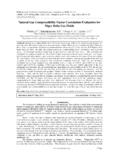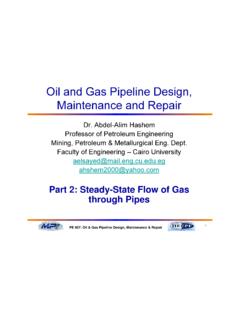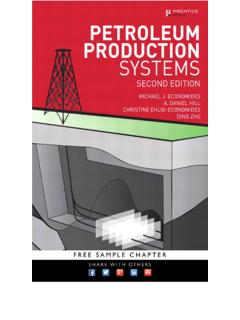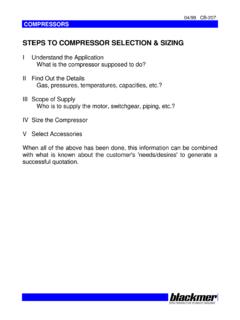Transcription of TECHNICAL BULLETIN - Industries
1 TECHNICAL BULLETINForm No. TB8102-3704 SW 10th Street Box 610 Blue Springs, Missouri 64013-0610 Phone: 816 229 3405 DISC SIZINGThe objective of this BULLETIN is to provide detailed guidance for sizing rupture discs using standard methodologies found in ASME Section VIII Div. 1, API RP520, and Crane TP-410. To assist in the sizing process, Fike offers DisCalc , a web based sizing program. See ALLOWANCEWhen sizing pressure relief devices, the ASME Code defines the maximum pressure that may build up in the pressure vessel while the device is relieving. This pressure varies depending on the application of the device. The following table defines the various overpressure allowances. See TECHNICAL BULLETIN TB8100 for ASME application (Sole Relieving Device)Secondary(Multi ple Devices)External Fire(Unexpected Source of External Heat)External Fire(Storage Vessels Only)Ref.
2 UG-125(c)Ref. UG-125(c)(1)Ref. UG-125(c)(2)Ref. UG-125(c)(3)10% or 3 PSIG, whichever is greater, above the vessel MAWP16% or 4 PSIG, whicever is greater, or above the vessel MAWP21% above the vessel MAWP20% above the vessel MAWPRUPTURE DISC SIZING METHODOLOGIEST hree basic methodologies for sizing rupture disc devices are described below. These methods assume single phase, non-reactive fluid flow. Resources such as API RP520 Part 1, the DIERS Project Manual, and CCPS Guidelines for Pressure Relief and Effluent Handling Systems provide other methods for two-phase, flashing, reactive, and otherwise non-steady state of discharge method (KD) - The KD is the coefficient of discharge that is applied to the theoretical flow rate to arrive at a rated flow rate for simple to flow method (KR) - The KR represents the velocity head loss due to the rupture disc device.
3 This head loss is included in the overall system loss calculations to determine the size of the relief capacity method - When a rupture disc device is installed in combination with a pressure relief valve (PRV), the valve capacity is derated by a default value of or a tested value for the disc/valve combination. See TECHNICAL BULLETIN TB8105 for specific application requirements when using rupture disc devices in combination with PRV s. A listing of Fike certified combination factors can be found in TECHNICAL BULLETIN OF DISCHARGE METHOD (KD)Use this method for simple systems where the following conditions are true (8 & 5 Rule). This method takes into account the vessel entrance effects, 8 pipe diameters of inlet piping, 5 pipe diameters of discharge piping, and effects of discharging to inlet and outlet piping is at least the same nominal pipe sizes as the rupture disc deviceThe rupture disc devicedischarges directly tothe atmosphereThe discharge pipingdoes not exceed 5 pipe diametersThe rupture disc isinstalled within 8 pipe diameters of the vessel2 of 9 GAS/VAPOR SIZINGD etermination of Critical vs.
4 Subcritical Flow per API RP520 Critical Pressure: Calculations per ASME Section VIII (assumes critical flow)Critical Flow: Calculation per API RP520 Subcritical Flow: Critical Flow: TABLE 1 TABLE 2 Gas Constants Gas Flow Constant C for Sonic Flow STEAM SIZING 2: )1/(12 kkcfkPPIfcfePP use critical flow equations MZTPCKWAZTMPACKWDD eDeDeDPPPSGZTKFVAPPPMZTKFVAPPPMZTKFWA 2228644645735 PCKSGZTVAPCKMZTVAMZTPCKWADDD W = rated flow capacity, (lb/hr) V = rated flow capacity, (SCFM) A = minimum net flow area, (sq. in.) C = constant based on the ratio of specific heats kk = cp/cvKD = coefficient of discharge for rupture disc devices F2= rrrkkkkk111/1/2r = PPeP = set pressure plus overpressure allowance plus atmospheric pressure (psia) Pe= exit pressure, (psia) M = molecular weight SG = specific gravity of gas at standard conditions, SG= for air at psia and 60 F T = absolute temperature at inlet (R= F + 460 F) Z = compressibility factor for corresponding to P and T.
5 Use if unknown. Page 2: )1/(12 kkcfkPPIfcfePP use critical flow equations MZTPCKWAZTMPACKWDD eDeDeDPPPSGZTKFVAPPPMZTKFVAPPPMZTKFWA 2228644645735 PCKSGZTVAPCKMZTVAMZTPCKWADDD W = rated flow capacity, (lb/hr) V = rated flow capacity, (SCFM) A = minimum net flow area, (sq. in.) C = constant based on the ratio of specific heats kk = cp/cvKD = coefficient of discharge for rupture disc devices F2= rrrkkkkk111/1/2r = PPeP = set pressure plus overpressure allowance plus atmospheric pressure (psia) Pe= exit pressure, (psia) M = molecular weight SG = specific gravity of gas at standard conditions, SG= for air at psia and 60 F T = absolute temperature at inlet (R= F + 460 F) Z = compressibility factor for corresponding to P and T.
6 Use if unknown. Page 2: )1/(12 kkcfkPPIfcfePP use critical flow equations MZTPCKWAZTMPACKWDD eDeDeDPPPSGZTKFVAPPPMZTKFVAPPPMZTKFWA 2228644645735 PCKSGZTVAPCKMZTVAMZTPCKWADDD W = rated flow capacity, (lb/hr) V = rated flow capacity, (SCFM) A = minimum net flow area, (sq. in.) C = constant based on the ratio of specific heats kk = cp/cvKD = coefficient of discharge for rupture disc devices F2= rrrkkkkk111/1/2r = PPeP = set pressure plus overpressure allowance plus atmospheric pressure (psia) Pe= exit pressure, (psia) M = molecular weight SG = specific gravity of gas at standard conditions, SG= for air at psia and 60 F T = absolute temperature at inlet (R= F + 460 F) Z = compressibility factor for corresponding to P and T.
7 Use if unknown. Page 2: )1/(12 kkcfkPPIfcfePP use critical flow equations MZTPCKWAZTMPACKWDD eDeDeDPPPSGZTKFVAPPPMZTKFVAPPPMZTKFWA 2228644645735 PCKSGZTVAPCKMZTVAMZTPCKWADDD W = rated flow capacity, (lb/hr) V = rated flow capacity, (SCFM) A = minimum net flow area, (sq. in.) C = constant based on the ratio of specific heats kk = cp/cvKD = coefficient of discharge for rupture disc devices F2= rrrkkkkk111/1/2r = PPeP = set pressure plus overpressure allowance plus atmospheric pressure (psia) Pe= exit pressure, (psia) M = molecular weight SG = specific gravity of gas at standard conditions, SG= for air at psia and 60 F T = absolute temperature at inlet (R= F + 460 F) Z = compressibility factor for corresponding to P and T.
8 Use if unknown. Gas or VaporMolecular Weightk = cp/cvAirAcetic AcidAcetyleneAmmoniaArgonBenzeneN-Butane ISO- ButaneButaneCarbon MonoxideCarbon DisulfideCarbon DioxideChlorineCyclohexaneEthaneEthyl AlcoholEthyl ChlorideEthyleneHeliumHydrochloric AcidHydrogenHydrogen SulfideMethaneMethyl AlcoholMethyl ChlorideNatural Gas (Avg.)Nitric AcidNitrogenOxygenPentanePropaneSulfur DioxideWater 2: )1/(12 kkcfkPPIfcfePP use critical flow equations MZTPCKWAZTMPACKWDD eDeDeDPPPSGZTKFVAPPPMZTKFVAPPPMZTKFWA 2228644645735 PCKSGZTVAPCKMZTVAMZTPCKWADDD W = rated flow capacity, (lb/hr) V = rated flow capacity, (SCFM) A = minimum net flow area, (sq. in.) C = constant based on the ratio of specific heats kk = cp/cvKD = coefficient of discharge for rupture disc devices F2= rrrkkkkk111/1/2r = PPeP = set pressure plus overpressure allowance plus atmospheric pressure (psia) Pe= exit pressure, (psia) M = molecular weight SG = specific gravity of gas at standard conditions, SG= for air at psia and 60 F T = absolute temperature at inlet (R= F + 460 F) Z = compressibility factor for corresponding to P and T.
9 Use if unknown. 3 of 9 STEAM SIZINGC alculation per ASME Section VIIIS team: Calculation per API RP520 Steam: TABLE 3 Superheat Correction Factors, KSH (API RP520 Part 1 Table 9)Burst Pressure (psig)Temperature 3: NDNDKKPWAKKPAW = = SHNDKKKPWA = NK = Correction factor for steam NK = when P 1500 psia NK = P> 1500 psia and P3200 psia SHK = See Table 3 for superheat steam correction factors. For saturated steam use Page 3: NDNDKKPWAKKPAW = = SHNDKKKPWA = NK = Correction factor for steam NK = when P 1500 psia NK = P> 1500 psia and P3200 psia SHK = See Table 3 for superheat steam correction factors. For saturated steam use Page 3: NDNDKKPWAKKPAW = = SHNDKKKPWA = NK = Correction factor for steam NK = when P 1500 psia NK = P> 1500 psia and P3200 psia SHK = See Table 3 for superheat steam correction factors.
10 For saturated steam use 4 of 9 LIQUID SIZINGC alculation per ASME Section VIIIW ater: Calculation per API RP520 Non-viscous liquid: Viscous liquid: For viscous liquid sizing, first calculate AR using KV of Apply the area A of the next larger size disc to the Reynoldsnumber calculations to arrive at KV. Then re-calculaterequired area AV using the derived KV. RESISTANCE TO FLOW METHOD (KR) Use this method when the 8 & 5 Rule does not apply and the rupture disc is not installed in combination with a pressure relief valve. This type of calculation is the responsibility of the system designer. DisCalcTM does not perform this type of of the Resistance to Flow Method Sizing is done on a relief system basis not by capacity of individual components Rupture disc is treated as another component in the relief system Each device or family of devices has a unit-less resistance value (KR) that represents the expected resistance to flow that is independent of the fluid flowing System relief capacity must be multiplied by a factor of of KRBecause many rupture discs have different opening characteristics depending on whether they are opened with a compressed vapor or incompressible liquid, there are certified KR values that are denoted by the applicable service media.







